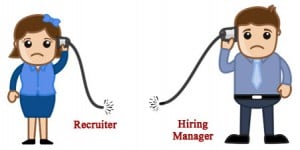What made me write this article is the agony of hiring managers they are going through and the problems recruiters are facing. Recently, a friend of my CEO visited our organization with a frustrated face. He was the Head for Marketing and Communications in his organization. My CEO asked him, “What’s your problem?”He started complaining about the employees who recently joined his organization. He said, “Recruiter is doing nothing. The candidate he selected doesn’t know the basics of marketing.”
Well! This is not the scenario in his organization itself. This will resonate with you if you are a recruiter or a hiring manager.
There’s a disconnect, largely based on desires and expectations not aligning. The miscommunication that too often occurs between recruiters and hiring managers is suppressing the hiring process. A successful hire wholly depends on the relationship between a recruiter and hiring manager and communication plays a pivotal role in hiring process.

Understanding where’s the Gap?
The traditional hiring processes are like: the hiring manager meets with a recruiter and tells him that they want the Gold Star – a candidate who has a specific skill set, will accept a less than adequate salary, work for long hours, and of course should be enthusiastic.
In few weeks, the recruiter forwards the list of names of selected candidates– almost none-of-whom meet the specified nearly impossible requirements. The hiring manager is left shaking his head, thinking the recruiter did not really understand what they wanted and recruited a candidate who is not fit for the organization or is a bad hire.
Bad Hire… Now what?
Bad hires happen. Recruiters make bad hires due to lack of attention and digging into candidates’ past work and real story. The time required to back-fill a bad hire and reinvent the requirement related wheel involves high-cost than simply getting it right the first time. Let’s face it, is kind of what companies expect from recruiters anyway.
And now you have to start the recruitment process all over again. There are ways where you can avoid hiring candidates that do not fit in the organizations.
1. Implement Assessments
The benefit of assessments is you can assess the competencies and skills of the candidates in a more realistic and engaging way. A 15-20 minutes test can be undertaken prior to the interview stage of the selection process. Integrate online pre-employment assessment software with the hiring process and evaluate candidates' skills for better hiring.
Anyone can claim to be an expert in something and it could be anything. The only way to see if a candidate is going to work well is, give the candidate an actual problem or challenge with real work illustrative that the particular position was created to overcome. Yes, there’s money and time involved in these trials but it’s better to evaluate candidates then to create a mess and anyways it doesn’t cost you thousands.
There’s much responsibility on the recruiter’s end. I am not saying hiring managers are irreproachable in this disconnect, however, the recruiter should be the one driving the process to fix the disconnect and can ultimately be successful in hiring better candidates.
How to fix it?
When there is an opening in your organization, it is important for the Human resources department to check inwardly if there is any existing staff that can fit perfectly into that position. If none, the next step should be to look outwardly. When it comes to evaluating a candidate for the particular role, first understand the fundamentals behind what you are assessing - whether performance, motivation, problem solving, communication, management competency or whatever. This understanding will help you to decide exactly what you need to evaluate and then which assessment tools will be most appropriate to utilize.
The goals for Recruiters and Hiring Managers are the same. All want to make new hires and want top talent in-house as quickly and cost effectively as possible without sacrificing skill, talent, or company culture. Working together is the best way to ease the diligence of the hiring process and communication is indispensable to the process.


